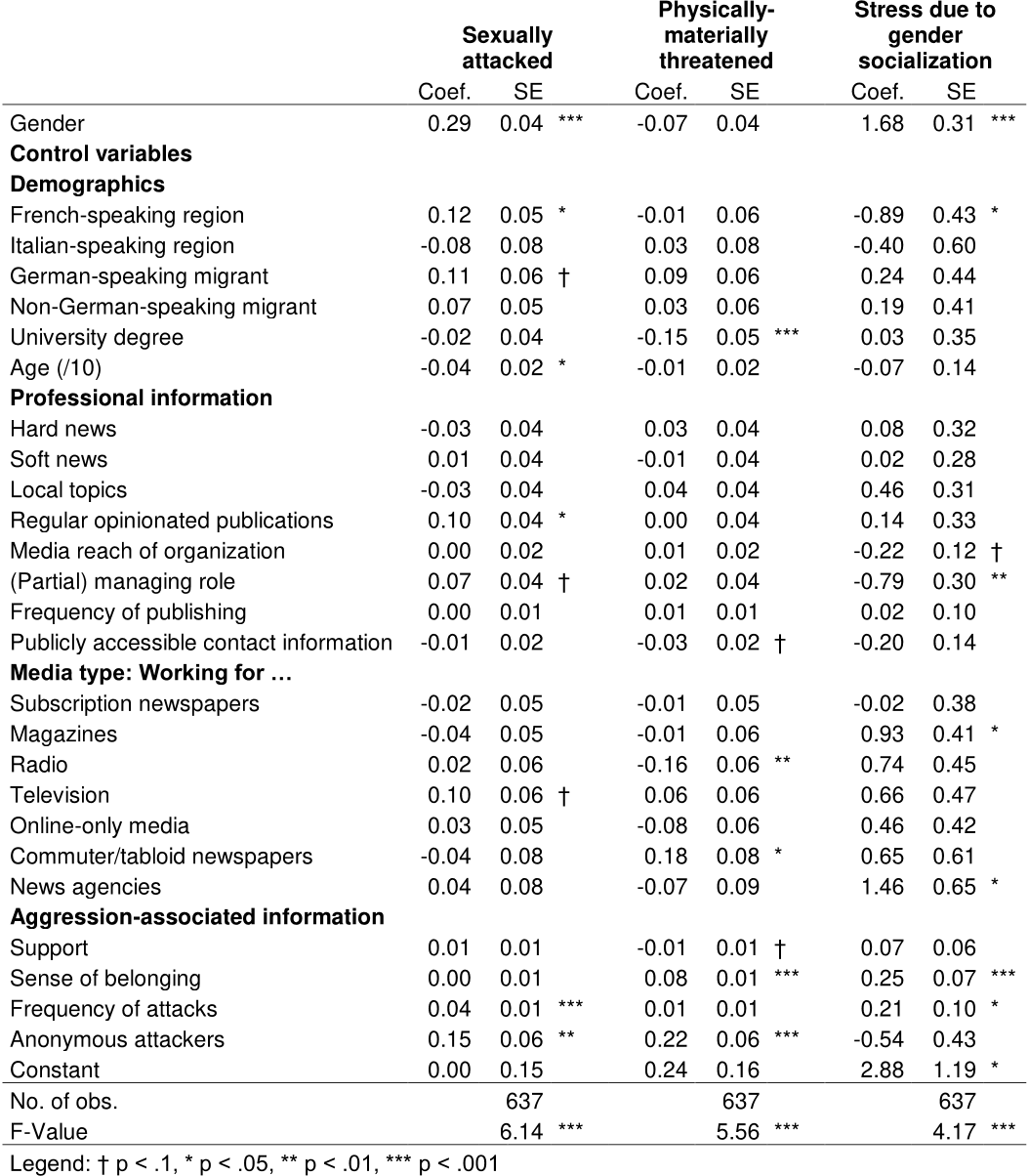




Did you find this useful? Give us your feedback












[...]
393 citations
70 citations
...These findings echo concerns raised by Stahel and Schoen (2019) that “unequal gender reactions to attacks can systematically disadvantage women.”...
[...]
...Women generally report a higher incidence of online harassment than men (Eckert, 2018; Mijatović, 2016; Stahel & Schoen, 2019)....
[...]
...In the end, “the original idea of involving the audience in news production, aimed at strengthening democratic structures and weakening exclusive gatekeeping ones ... might boomerang; it may promote inequality within the journalistic profession” (Stahel & Schoen, 2019, p. 16)....
[...]
...…that one gender is more often placed in situations (such as audience-facing roles) that elicit greater possibilities for harassment, a difference that could account for much of their greater reported rates of harassment (see also Löfgren Nilsson & Örnebring, 2016; Stahel & Schoen, 2019)....
[...]
...This led them to conclude that their study, at least in Switzerland, “contradicts the image of women as the main target of particularly severe attacks” (cf. Binns, 2017; Stahel & Schoen, 2019, p. 15)....
[...]
25 citations
22 citations
19 citations
...This is evident in the way newsrooms control comments section as much as in the tactics that journalists choose to manage public access to their contact information and privacy, as well as their social media activity (Bossio and Holton 2019; Stahel and Schoen 2019; Xia et al. 2020)....
[...]
144 citations
137 citations
...Imposing more severe sanctions is commonly expected to increase people’s compliance and to motivate them, for example, to avoid undesired behavior even more (Garoupa, 2001; Tittle and Logan, 1973; Wenzel, 2004)....
[...]
...Drawing on the reasoning of sanction severity (Garoupa, 2001; Tittle and Logan, 1973; Wenzel, 2004), gender roles (Berger et al., 1980; Eagly and Wood, 2011) and the status incongruity hypothesis (Rudman et al., 2012), we expect journalists who do not conform to gender role expectations to be more…...
[...]
...This initially disconfirms any theoretical stronger deterrent effect of more severe sanctions (Garoupa, 2001; Tittle and Logan, 1973; Wenzel, 2004)....
[...]
...Generally, negative sanctions motivate people to conform (Tittle and Logan, 1973)....
[...]
132 citations
...Journalists have selectively reported that attacks motivated them to consider more diverse perspectives and thus report in a more balanced way (Chen et al., 2018)....
[...]
...Journalists worldwide have mentioned this strategy in surveys and interviews, for example, among 440 female and male journalists surveyed in Germany (Preuss et al., 2017) and among journalists in other countries (Adams, 2018; Chen et al., 2018; Nilsson and Örnebring, 2016)....
[...]
...For example, among journalists, it is predominantly female journalists who report avoiding attacks by closing their social media accounts or stopping writing for the public, and, thus, self-selecting out of the public sphere (Adams, 2018; Chen et al., 2018; Friedersdorf, 2014; Sletvold Øistad, 2015)....
[...]
...…prevalence of being physically–materially threatened rather contradicts the image of women as the main target of particularly severe attacks (e.g. Chen et al., 2018; Ferrier and GarudPatkar, 2018; Friedersdorf, 2014; Tofalvy, 2017) and specifically of women in journalism being particularly…...
[...]
...…example, among journalists, it is predominantly female journalists who report avoiding attacks by closing their social media accounts or stopping writing for the public, and, thus, self-selecting out of the public sphere (Adams, 2018; Chen et al., 2018; Friedersdorf, 2014; Sletvold Øistad, 2015)....
[...]
123 citations
...One example is receiving hate speech, “often considered the rough edges of society that people are asked to tolerate in a free society” (Leets, 2002: 357)....
[...]
...The stronger stress motivates female journalists to apply avoidance strategies to reduce the stress and the adverse effects arising from it (Leets, 2002)....
[...]
...When individuals are confronted with attacks and hate speech, whether offline or online, they cope with it by adapting their attitudes and their behaviors (e.g. Leets, 2002)....
[...]
...To buffer the resulting worries and tension, they adapt their attitudes and behaviors (e.g. Leets, 2002)....
[...]
...We use the literature on coping (e.g. Chen et al., 2018; Fox and Tang, 2017; Leets, 2002) to examine journalists’ responses to attacks....
[...]
110 citations
...Combined with other evidence showing that online harassment generally affects women more strongly than men (Kenski et al., 2017; Pew Research Center, 2014), this suggests that female public figures might be more likely than male public figures to use avoidance strategies as responses to attacks....
[...]
...…for attacking and harassing feedback: compared with men, women perceive a broader range of social–sexual behaviors to be forms of harassment (Rotundo et al., 2001), are more sensitive to uncivil online comments (Kenski et al., 2017), and are more upset by online attacks (Pew Research Center, 2014)....
[...]
...…the theoretical reasoning on gender-typed self-concepts and the empirical evidence on gendered stress (Dedovic et al., 2009; Eagly and Wood, 2011; Kenski et al., 2017; Rudolph and Hammen, 1999), we expect that the gender difference in the response to attacks is a result of gender socialization....
[...]
...Our theoretical framework may also help to explain empirical, but not yet theoretically embedded, findings of female journalists and women generally seeming more upset by online harassment than their male equivalents (Binns, 2017; Kenski et al., 2017; Pew Research Center, 2014)....
[...]